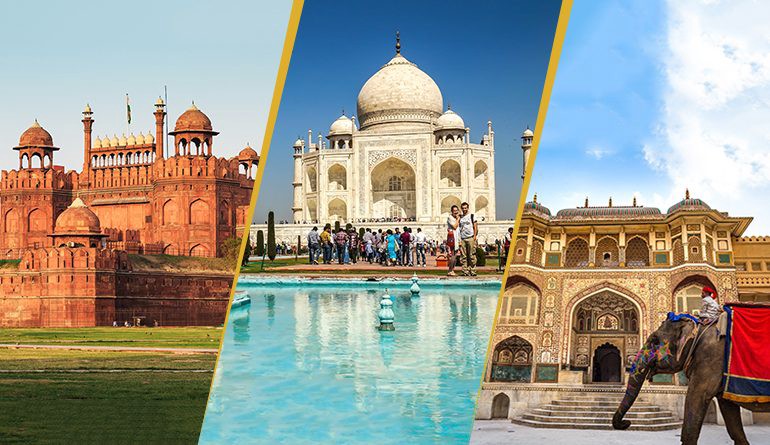India’s Golden Triangle is one of the most iconic and sought-after travel routes in the country, connecting three historically and culturally rich cities: Delhi, Agra, and Jaipur. This route forms a triangle on the map, with each city lying approximately 200-250 kilometers apart. Traveling through the Golden Triangle India is an immersive experience, offering a glimpse into the country’s fascinating history, architectural marvels, and vibrant culture. Whether you’re a history enthusiast, a lover of art, or simply seeking adventure, this journey through the Golden Triangle is sure to leave you captivated.
Delhi: The Gateway to the Golden Triangle
The journey through the Golden Triangle India begins in the bustling capital city of Delhi. Known for its rich history and modern dynamism, Delhi offers a seamless blend of the old and the new. The city is home to some of India’s most significant landmarks and historical monuments.
Start your exploration at the Red Fort, a UNESCO World Heritage Site that stands as a symbol of India's struggle for independence. The massive red sandstone structure, built by Mughal Emperor Shah Jahan, offers a peek into the grandeur of the Mughal Empire. From here, head to Jama Masjid, one of the largest mosques in India, with stunning views of Old Delhi’s bustling streets.
For a more modern side of the city, explore India Gate, a war memorial dedicated to Indian soldiers who died in World War I. Nearby, you can visit the Rashtrapati Bhavan (President’s House) and the Parliament House, which symbolize India’s democratic heritage.
Delhi’s markets are also a haven for shoppers and food lovers. Wander through Chandni Chowk, where you can taste traditional Indian street food, or visit Connaught Place for a mix of high-end brands and local handicrafts.
Agra: Home to the Taj Mahal
From Delhi, the next stop on the Golden Triangle India route is Agra, famous for being home to one of the Seven Wonders of the World, the Taj Mahal. This architectural masterpiece, built by Mughal Emperor Shah Jahan in memory of his wife Mumtaz Mahal, is renowned for its white marble façade and intricate design. Visiting the Taj Mahal during sunrise or sunset offers a magical experience, as the monument changes colors with the shifting light.
In addition to the Taj Mahal, Agra boasts other magnificent Mughal-era monuments. The Agra Fort, another UNESCO World Heritage Site, stands as a testament to the grandeur and strategic prowess of the Mughal dynasty. Wander through its palaces, halls, and courtyards to get a sense of life within the fort during its heyday.
For a deeper dive into Mughal history, visit Fatehpur Sikri, located about 35 kilometers from Agra. This former capital of the Mughal Empire is a well-preserved ghost town that offers a fascinating look into Mughal architecture and planning.
Jaipur: The Pink City of India
The final stop on the Golden Triangle India route is Jaipur, the capital city of Rajasthan, also known as the Pink City. Jaipur is famous for its royal heritage, colorful streets, and grand palaces. One of the highlights is the Amber Fort, located on the outskirts of the city. This hilltop fortress offers breathtaking views of the surrounding landscape and showcases a fusion of Hindu and Mughal architecture.
Within Jaipur, the City Palace is another must-visit destination. This sprawling complex includes gardens, courtyards, and museums that offer insights into the royal family’s life. Don’t miss the Hawa Mahal, or Palace of Winds, with its unique façade designed to allow royal women to observe street festivities without being seen.
Jaipur is also a shopper's paradise, known for its vibrant markets where you can find traditional Rajasthani textiles, jewelry, and handicrafts. The city’s bazaars, such as Johari Bazaar and Bapu Bazaar, offer an array of souvenirs and local goods that showcase the craftsmanship of Rajasthan.
Best Time to Visit the Golden Triangle
The best time to visit the Golden Triangle India is during the cooler months, from October to March, when the weather is pleasant for sightseeing and outdoor activities. Summers can be scorching, particularly in Agra and Jaipur, while the monsoon season can make travel difficult due to heavy rains. However, winter months provide an ideal climate for exploring the monuments and bustling markets.
Conclusion
A journey through the Golden Triangle India is more than just a sightseeing trip; it’s an immersive experience into the soul of India. From the bustling streets of Delhi to the timeless beauty of the Taj Mahal in Agra and the royal heritage of Jaipur, this route showcases the country’s rich history, diverse culture, and architectural splendor.
Whether you’re a first-time visitor or a seasoned traveler, the Golden Triangle offers an unforgettable adventure through India’s most iconic destinations, making it a must-visit for anyone looking to explore the heart of the subcontinent.






Comments